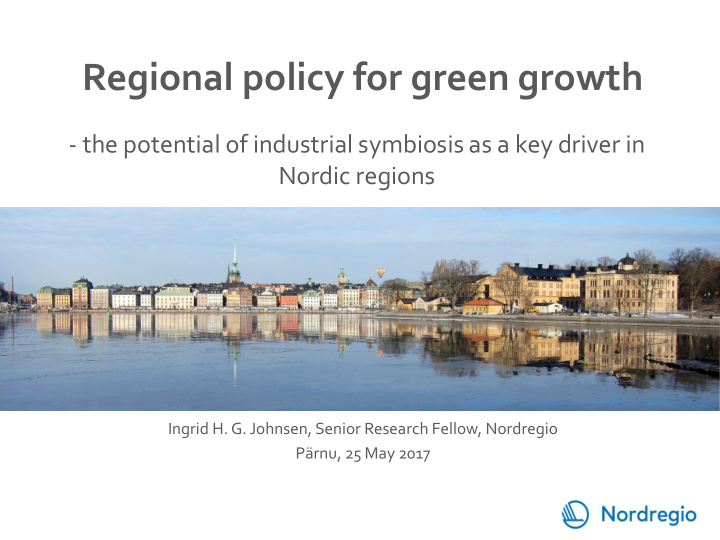



Regional policy for green growth - the potential of industrial symbiosis as a key driver in Nordic regions Ingrid H. G. Johnsen, Senior Research Fellow, Nordregio Pärnu, 25 May 2017
Presentation outline 1. What is circular economy (CE) and industrial symbiosis (IS)? 2. Empirical findings a. National policy review b. Regional case studies 3. Conclusions: the potential of industrial symbiosis as a key driver for green growth in Nordic regions
What is circular economy? A production and consumption system that creates as little economic loss as possible, and where the majority of the products and the resources used in production processes can be reused or recycled An alternative to the "take, make, dispose" industrial processes and lifestyles Photo: http://beyondsustainable.org/wp-content/uploads/2016/06/The-Circular-Economy.bmp
”Think of it as a bike” Can be refurbished Easy to repair Durable Upgradable to meet new needs You can buy it, rent it or use a share system Materials can be reused after end use Positive impact Runs on renewable period in use energy Source: Jasper Steinhausen, COWI
One company’s waste is another company’s resource Physical exchanges of resources among firms that can be used as substitutes for commercial products or raw-materials Promotes sustainable resource use by minimising input of virgin materials and eliminating waste An innovative way to increase resource productivity through improved business- and technical processes Source: Rise (2015)
Three types of resource exchanges Photo: Yadid Levy / Norden.org a) By-product reuse b) Utility/infrastructure sharing c) Joint provision of services Photo: Rasmus Ole Rasmussen
Drivers for developing industrial symbiosis Economic : Minimised costs in waste management and resources purchases Environmental : Resource efficiency through reuse, recycling, and reduced intake of virgin materials Innovation and development : Improved introduction and access to new technologies and R&D, job creation and regional development Photo: Vita Thomsen/Norden.org
Policies supporting circular economy and industrial symbiosis Finland and Denmark – National industrial symbiosis strategies – CE/IS is seen as an important tool in regional development Norway, Sweden and Iceland – No national-level strageies – Focus on CE/IS through research programmes, regional authorities, universities and Photo: Sigurður Ólafsson/norden.org industry
Nordic regional industrial symbiosis cases
Industrial symbiosis in the processing industry in Agder, Norway Key actors: – Processing industry – EYDE cluster organisation 13 member companies (3,000 employees) Total annual turnover of 1.15 billion EUR Photo: https://www.eydecluster.com/no/ High demands for productivity and sustainable production from international owners
EYDE waste to value By-product reuse Mapping of all materials produced at seven Eyde-cluster core members Aims to – Recover metals from Fe- and SiMn sludges – Utilise carbon from waste streams related to the smelting of aluminum – Minimse need for future waste deposit Source: http://industri.norskindustri.no
Critical factors for developing industrial symbiosis in Agder Drivers – Strong interest from the processing industry to develop environmentally friendly solutions – Presence of cluster organisation – Support from regional authorities – Opportunities for new businesses and jobs Barriers – Lack of long-term financial support schemes – Lack of comprehensive strategy for the development of sustainable processing industry in Norway
Industrial symbiosis has the potential to become a key driver for green growth in Nordic regions Strong interest from companies to engage in industrial symbiosis Public support for industrial symbiosis at regional and (to some extent) national level There are future opportunities for new companies and jobs based on industrial symbiosis activities Photo: Sigurður Ólafsson/norden.org
Economic gains and environmental regulations are key motivating factors Private companies are the key actors driving industrial symbiosis development in Nordic regions Industrial symbiosis strengthens companies’ environmental profiles Co-ordinating bodies (e.g. cluster organisation) are key enablers Photo: Benjamin Suomela / Norden.org
Recommend
More recommend